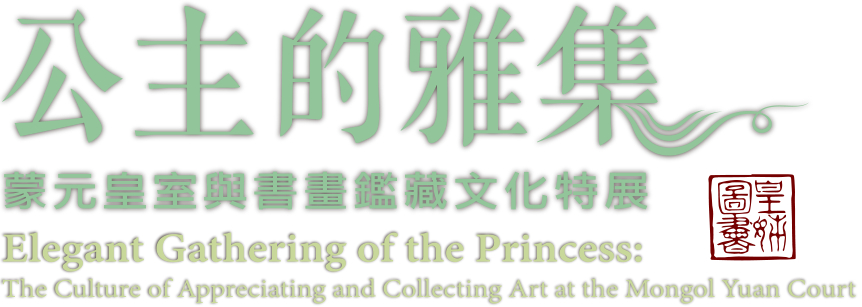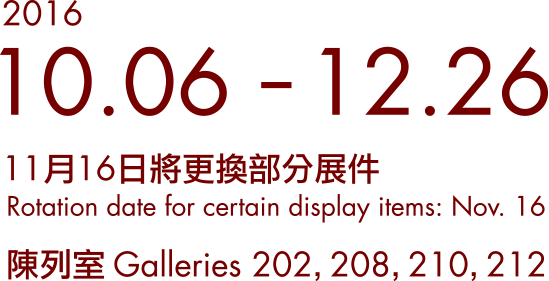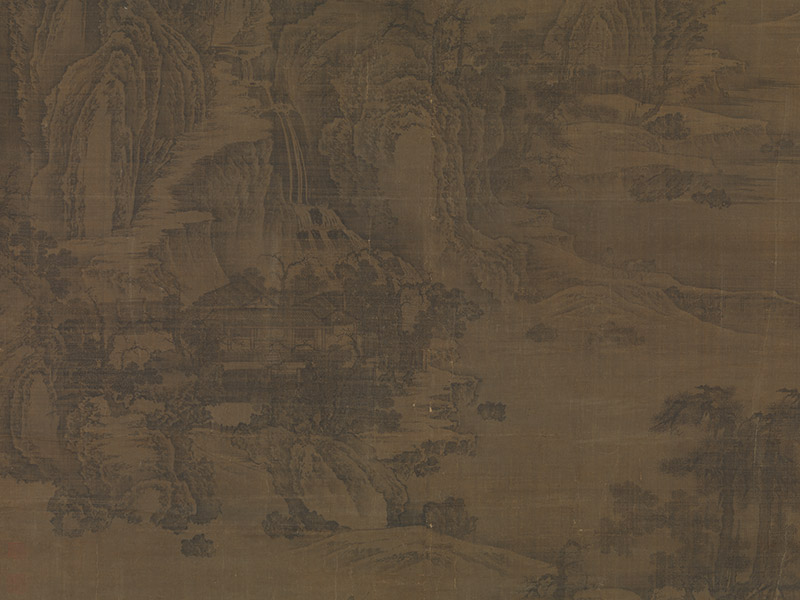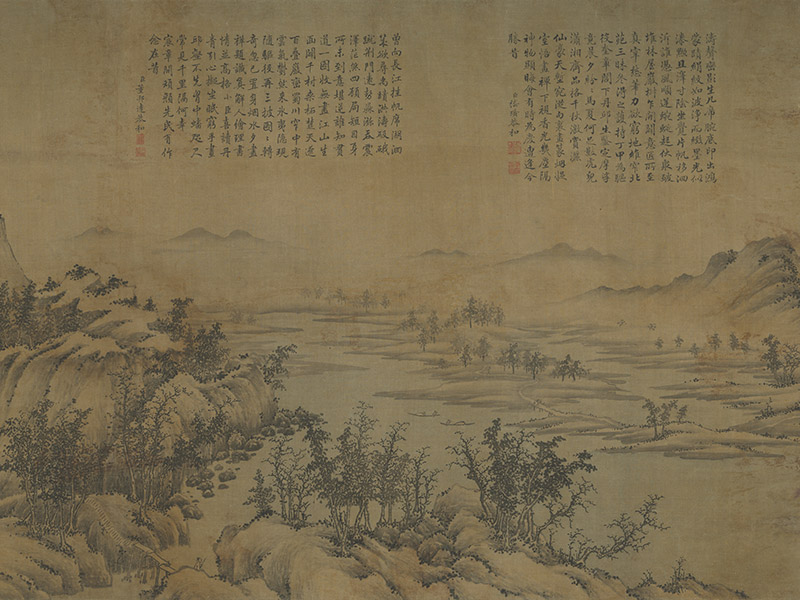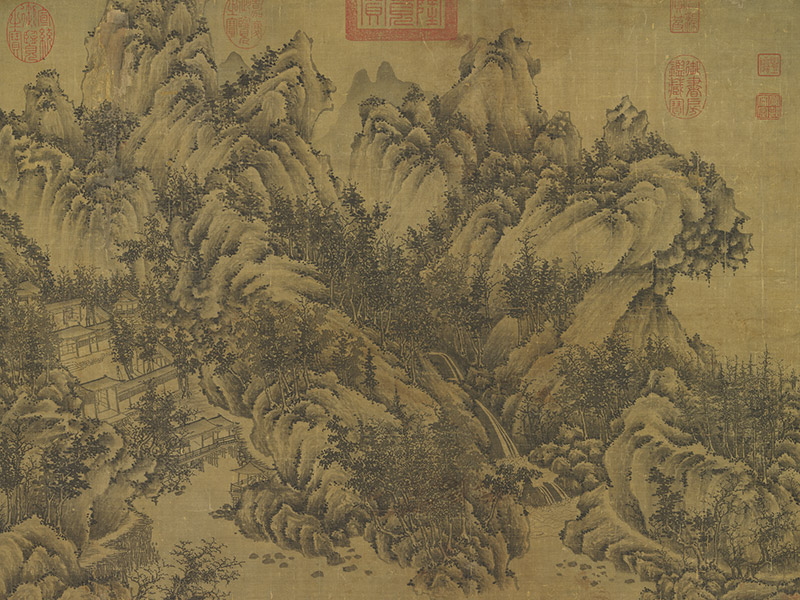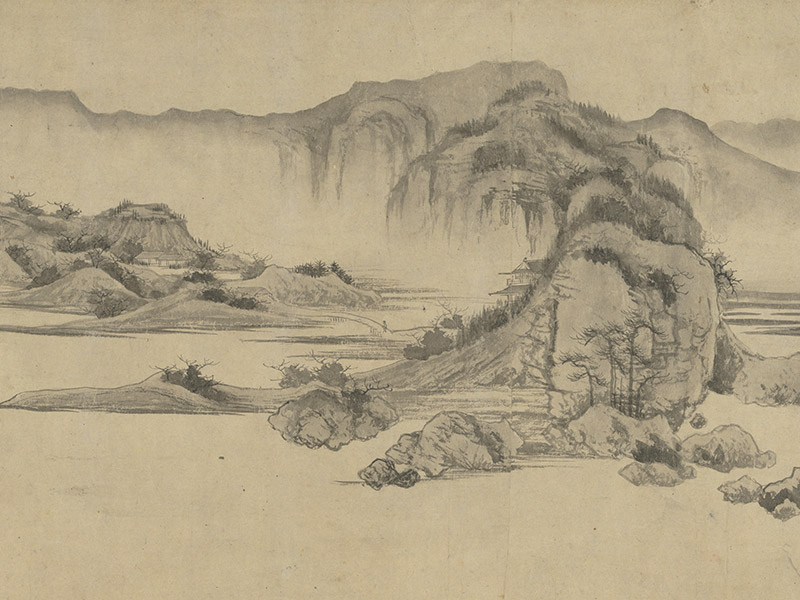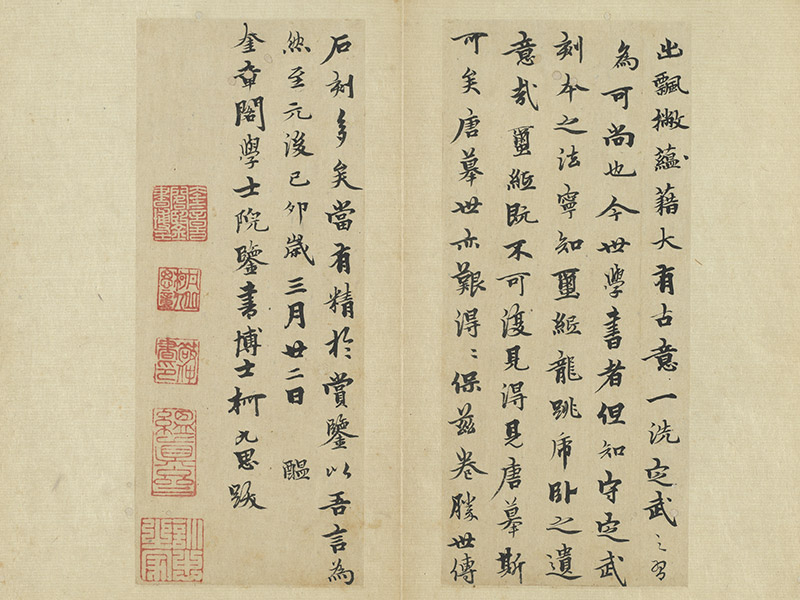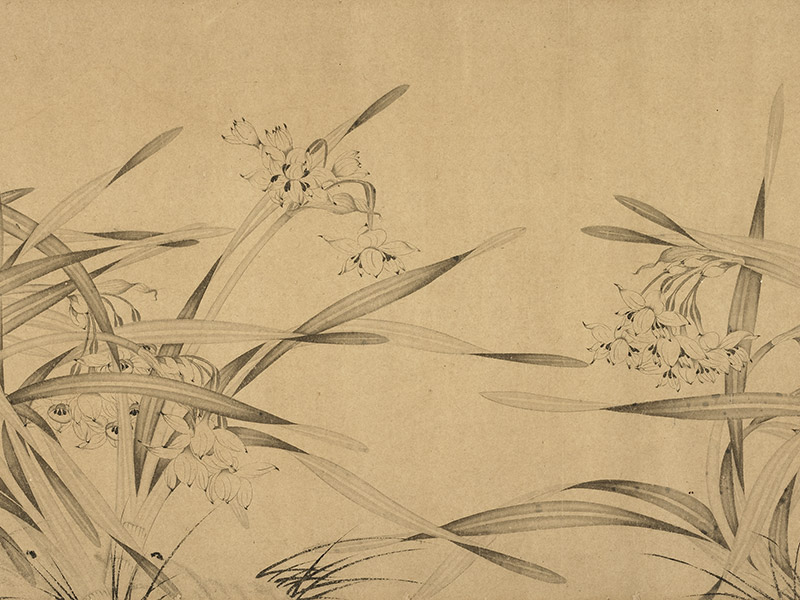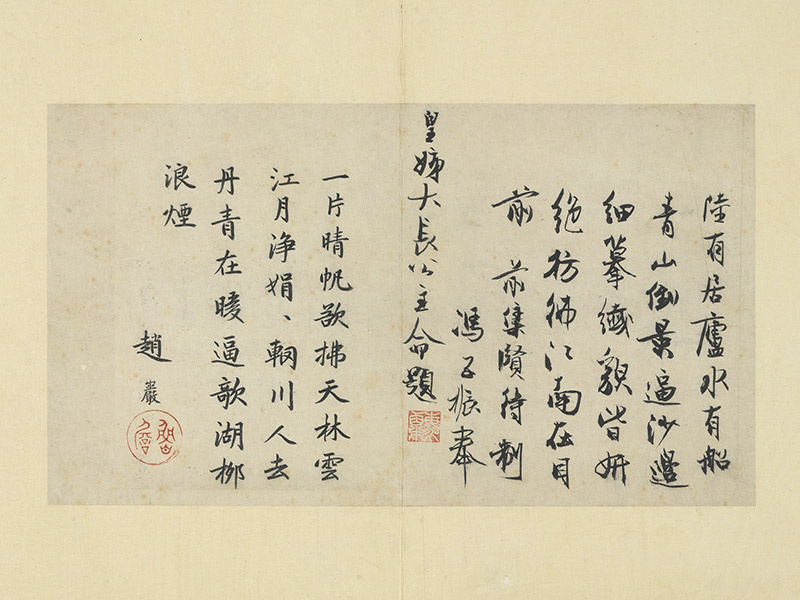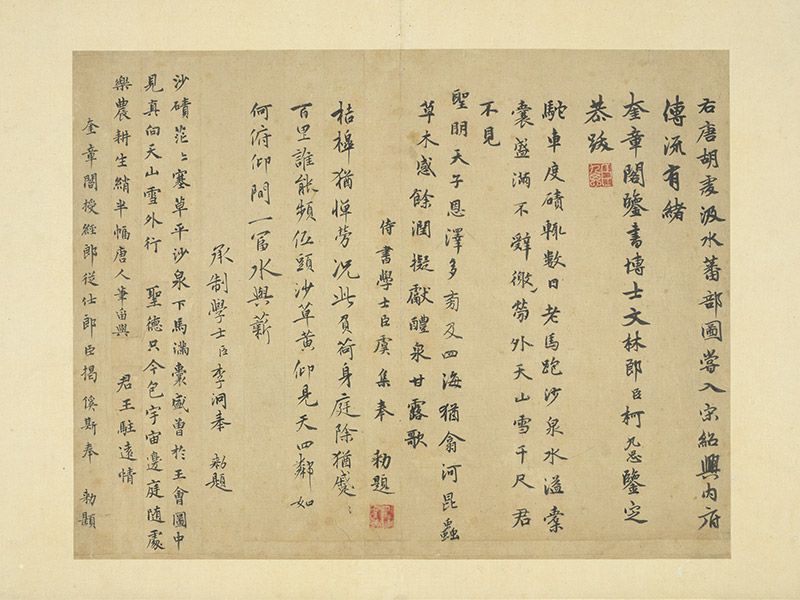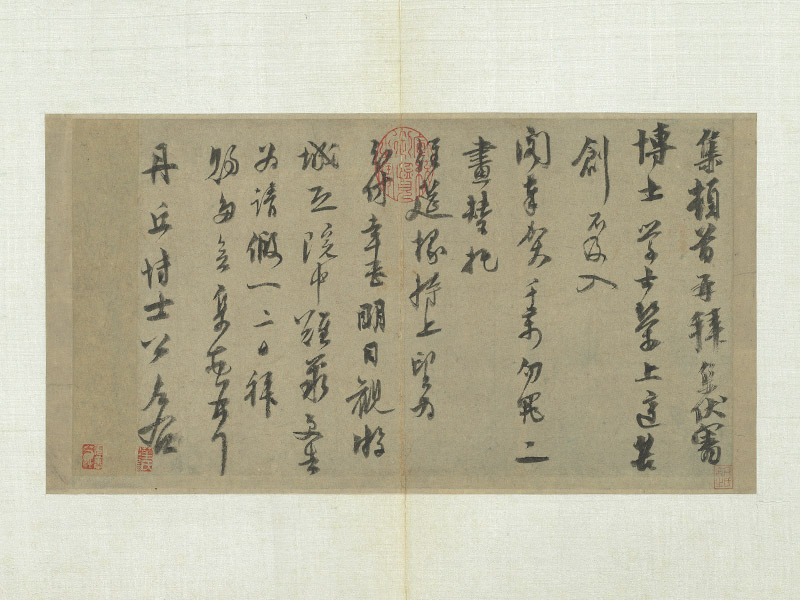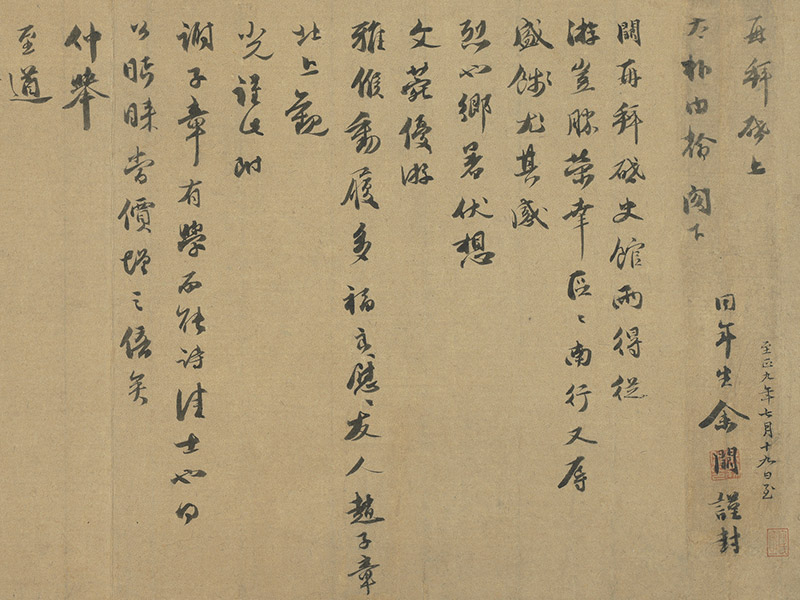Collecting activities conducted by members of the Mongol Yuan imperial family were closely related to those of court scholars and officials during this period. For example, Yuan Jue took part in Princess Sengge Ragi's elegant gathering and left an invaluable record of this event at Tianqing Temple. Feng Zizhen and Zhao Yan also frequently wrote inscriptions for works in her collection. The album "Calligraphy by Yuan Figures" in the National Palace Museum contains poetic inscriptions they did for one of her paintings. In addition, Ke Jiusi and Yu Ji, who served as consultant and connoisseur of painting and calligraphy for Emperor Wenzong, left behind numerous inscriptions. For instance, the signature and inscription of Ke Jiusi, Erudite of the Kuizhang Pavilion under Wenzong, appears after Lu Jishan's "Copy of the Orchid Pavilion Preface." Jing Hao's "Mt. Kuanglu" and "A Thousand Miles of Rivers and Mountains" ascribed to Jiang Shen also bear inscriptions by Ke.
Writings by court scholar-officials on one hand provide material evidence for the support of Chinese painting and calligraphy by the Mongol Yuan imperial family. On the other hand, they also testify to the interaction and participation among scholars of different ethnic backgrounds, including the ways in which they utilized their cultural knowledge in the collecting activities of the rulers. Inscriptions by related Yuan figures are plentiful, and many examples can still be found on surviving works of painting and calligraphy from the Song and Yuan dynasties. For instance, after Zhao Mengfu's "Layered Riverbanks and Serried Peaks" in the National Palace Museum collection are inscriptions by Yu Ji, Shi Yan, and Liu Guan. The contents of scholars' inscriptions not only echo the artistic expression of the works on which they appear, the attitudes revealed within make them invaluable for understanding the arts of Chinese painting and calligraphy during the Mongol Yuan period.
Mt. Kuanglu
Rotation 1 10/6-11/15
- Attributed to Jing Hao (fl. 10th c.), Five Dynasties period
- Hanging scroll, ink on silk, 185.8 x 106.8 cm
On the left side of the composition stands a cluster of peaks, the layers connecting with the level distance space at the right. In addition to a winding path, buildings are scattered here and there, the thrust of the mountains formed on the right side no longer following the landscape formula of the early Northern Song. Instead, it is closer to that of the twelfth century or later. Areas of void appear on the mountaintops with tree clusters, creating an unusual manner that demonstrates a new understanding of the Jing Hao tradition in the later Northern Song period. The actual style of paintings done afterwards in Jing Hao's name, however, requires further study. Two other works of similar composition in the Museum collection can also be seen as patterned after this hanging scroll.
A Thousand Miles of Mountains and Rivers
- Jiang Shen (fl. early 12th c.), Song dynasty
- Handscroll, ink on silk, 46.3 x 546.5 cm
According to the literary anthology of Yuan Jue, Princess Sengge Ragi in the Yuan dynasty had in her collection a painting by Jiang Shen entitled "Mists and Rain." The handscroll here depicts layers of forested hills and mountains with scenery of riverbanks and marshes interspersed with human activity, such as travelers on a mountain path. The "alum heads" for the mountaintops and use of ink dots reflect a continuation of the landscape tradition associated with the tenth-century artists Dong Yuan and Juran. Whether this work is actually an authentic example of Jiang's painting, however, is still a matter of debate.
Autumn Mountains
- Anonymous, Yuan dynasty (1279-1368)
- Hanging scroll, ink on silk, 46.3 x 57.1 cm
Layered Riverbanks and Serried Peaks
- Zhao Mengfu (1254-1322), Yuan dynasty
- Handscroll, ink on paper, 28.4 x 176.4 cm
Zhao Mengfu pursued ancient styles, this work belonging to the Li-Guo tradition of Li Cheng and Guo Xi, to which he added elements from the level distance landscape mode of Wang Shen in the late Northern Song. The composition reflects old methods of the Song, but the brushwork for the mountain forms, perhaps as a result of copying, appear more formulaic. The contents of the colophons by Yu Ji and Liu Guan are found in their respective literary anthologies, and the frontispiece title for the painting was written in seal script by Cheng Nanyun of the early Ming dynasty.
Copy of the Orchid Pavilion Preface
- Lu Jishan (1298-1345), Yuan dynasty
- Album leaf, ink on paper, 25.4-25.7 x 10.5-12.8 cm
At the end are inscriptions by such Yuan dynasty figures as Ke Jiusi, Jie Xisi, Chen Lü, Chen Fang, Huang Jin, and Ni Zan, most of whom had been invited by Lu Jishan to write after viewing the work. Ke Jiusi also signed his name using his title of Literary Erudite-Academician of the Kuizhang Pavilion, a post he held under Emperor Wenzong (Tugh Temür). In particular, Ke noted that this copy by Lu of the "Orchid Pavilion Preface" came from an ink rubbing made by Chu Suiliang. Representing a lineage differing from the one for the "Dingwu Copy of the Orchid Pavilion Preface," he felt it had great archaism and to be superior.
Narcissi
- Zhao Mengjian (1199-1264), Song dynasty
- Handscroll, ink on paper, 32.7 x 1021.6 cm
In terms of visual effect, Zhao Mengjian emphasized the expressiveness of ink on the painting surface to create a rich and varied appearance. In the early Yuan dynasty, many scholars highly praised Zhao's ink flower painting. Although the inscriptions by Yuan figures at the end of this scroll are copies, they nonetheless testify to this phenomenon.
Seven-Character Truncated Verses Inscribed for a Painting
- Feng Zizhen (1257-1348) and Zhao Yan (dates unknown), Yuan dynasty
- Album leaf, ink on paper, 28 x 49.3 cm
In 1286, Kublai Khan had placed a call for sages in the Jiangnan region, and Feng Zizhen and Zhao Yan were both recommended to the Yuan court and came to serve as Jixian ("Scholarly Worthies") Attendant Academicians. Zhao Yan was also in the service of the Prince of Lu, an imperial son-in-law, and once composed a rhapsody for and appreciated by Sengge Ragi. In fact, many of the works in her collection bear inscriptions of poetry by these two scholars.
Inscriptions for a Painting
- Ke Jiusi (1290-1343), Yu Ji (1272-1348), Li Jiong (1274-1332), and Jie Xisi (1274-1334), Yuan dynasty
- Album leaf, ink on paper, 40.9 x 54.9 cm
According to Ke Jiusi's record, the title of the handscroll painting was "Hu Qian Crossing Waters to Barbarian Land," which had passed through the Southern Song imperial collection. The three other Yuan scholars had also received "imperial orders to do inscriptions," indicating that they served the Mongol Yuan court and that the painting in question was part of the imperial Yuan collection. All four scholars served as officials at the Kuizhang Pavilion, and the inscriptions were probably done after viewing the work. The contents by Yu Ji and Jie Xisi are also recorded in their respective literary anthologies.
Letter to Honorable Erudite Danqiu
- Yu Ji (1272-1348), Yuan dynasty
- Album leaf, ink on paper, 21 x 37.7 cm
This letter in semi-cursive script was written to Ke Jiusi, apologizing on account of illness for not congratulating him earlier on his promotion to Erudite at the Kuizhang Pavilion. Yu also refers to two eulogies on paintings that he had presented, thereby demonstrating the close friendship between these two figures. Yu Ji followed the idea of revivalism advocated by Zhao Mengfu, achieving the essence of Jin calligraphers. The style of the work here, as a result, is pure and natural with a spirited and classical atmosphere.
Letter to Palace Writer of the Imperial Stud
- Yu Que (1303-1358), Yuan dynasty
- Album leaf, ink on paper, 29.3 x 67.4 cm
This work is a letter that Yu Que wrote to the "Palace Writer of the Imperial Stud," a reference to Wei Su (1303-1372), who had been appointed to the Hanlin Academy. At the right is a date for the "nineteenth day of the seventh month of the ninth year in the Zhizheng reign," corresponding to August 3, 1349; it probably represents when the missive was received. In the letter, Yu first thanks Wei Su for giving him a farewell dinner before commencing on his trip south. Also, because a friend of Yu's was traveling north to Dadu, he wrote to ask Wei for a favor to provide a recommendation for his friend. The style of Yu's calligraphy here may seem careless at first but actually is much in the manner of the Jin dynasty.
